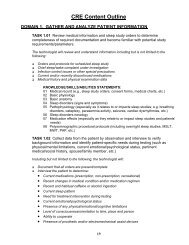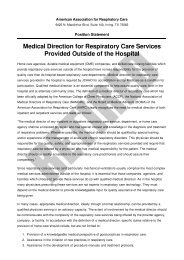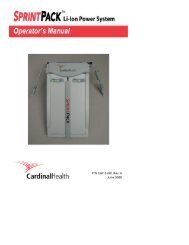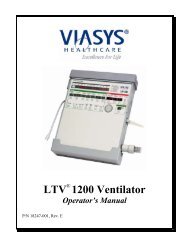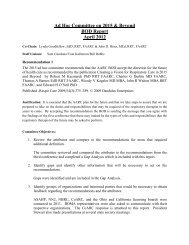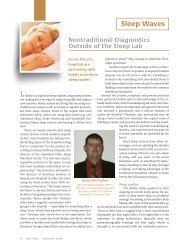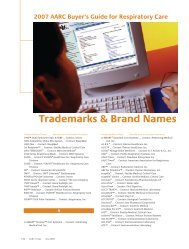Aerosol Guide - AARC.org
Aerosol Guide - AARC.org
Aerosol Guide - AARC.org
You also want an ePaper? Increase the reach of your titles
YUMPU automatically turns print PDFs into web optimized ePapers that Google loves.
jet nebulizer delivers compressed gas through a jet, causing a region of negative pressure.<br />
The solution to be aerosolized is entrained into the gas stream and is sheared into a liquid<br />
film. This film is unstable and breaks into droplets due to surface tension forces. A baffle in<br />
the aerosol stream produces smaller particles. The performance of jet nebulizers is affected<br />
by both the technical and patient-related factors described in Table 8.<br />
Table 8. Factors affecting penetration and deposition of therapeutic aerosols delivered by jet<br />
nebulizers (Modified, with permission, from Reference 1)<br />
Technical Factors<br />
Design and model of nebulizer<br />
Flow used to power nebulizer<br />
Fill volume of nebulizer<br />
Solution characteristics<br />
Composition of driving gas<br />
Designs to enhance nebulizer output<br />
Continuous vs. breath-actuated<br />
Patient Factors<br />
Breathing pattern<br />
Nose vs. mouth breathing<br />
Composition of inspired gas<br />
Airway obstruction<br />
Positive pressure delivery<br />
Artificial airway and mechanical ventilation<br />
Factors Affecting Jet Nebulizer Performance and Drug Delivery<br />
There are many factors for respiratory therapists to keep in mind during aerosol therapy.<br />
Nebulizer design determines the size of particle and output performance produced, which results<br />
in the ultimate efficiency of medication according to the factors discussed below. Various types of<br />
nebulizers are available on the market, and several studies have indicated that performance varies<br />
between manufacturers and also between nebulizers from the same manufacturer. 1,33,34<br />
• Gas Flow and Pressure: Jet nebulizers are designed to operate by means of varied levels<br />
of compressed gas flow and pressure. Each model of jet nebulizer is designed to work best<br />
at a specific flow, ranging from 2–8 L/min, which should be listed on the device label.<br />
Operating any jet nebulizer at a lower flow or pressure will increase particle size. For<br />
example, a jet nebulizer designed to operate at 6–8 L/min at 50 psi will produce larger<br />
particles if driven by a compressor producing 13 psi. Consequently, jet nebulizers should<br />
be matched with a compressor or gas source that matches their intended design. Gas flow<br />
is also inversely related to nebulization time. Using a higher gas flow rate in aerosol therapy<br />
will decrease the amount of treatment time needed to deliver the set amount of drug.<br />
• Fill and Dead Volumes: Increasing the fill volume is another factor that increases the<br />
efficiency of jet nebulizers. These nebulizers do not function well with small fill volumes<br />
like 2 mL or less because this is close to dead volume (also termed residual volume). Jet<br />
nebulizers do not aerosolize below dead volume; therefore, it is recommended to use a<br />
fill volume of 4–5 mL unless the nebulizer is specifically designed for a smaller fill volume.<br />
1,34 This precaution dilutes the medication, allowing for a greater proportion to be<br />
nebulized, though it increases the treatment time. Dead volume, the amount of medication<br />
remaining in the jet nebulizer at the end of a treatment, can range from 0.5 to 2.0<br />
mL. The greater the dead volume, the less drug is nebulized.<br />
• Gas Density: By a similar offsetting, the density of gas used to run a jet nebulizer can<br />
impact aerosol deposition by affecting aerosol output and particle size. For example, delivering<br />
aerosol with heliox can increase lung deposition by as much as 50%. Using heliox at<br />
the same flow rate as with air or oxygen reduces particle size and aerosol output, ultimately<br />
increasing treatment times. Consequently, the flow with heliox should be increased by<br />
1.5–2 times to bring particle size and output back to levels achieved with air or oxygen.<br />
• Humidity and Temperature: Humidity and temperature can also affect particle size<br />
and residual volume. Specifically, water evaporation during aerosol therapy can reduce<br />
12 American Association for Respiratory Care A <strong>Guide</strong> to <strong>Aerosol</strong> Delivery Devices for Respiratory Therapists, 3rd Edition © 2013



